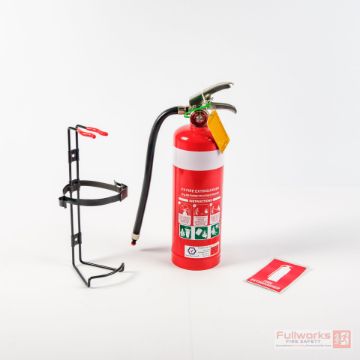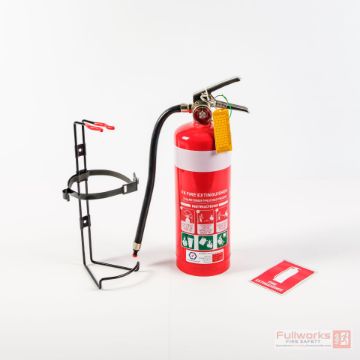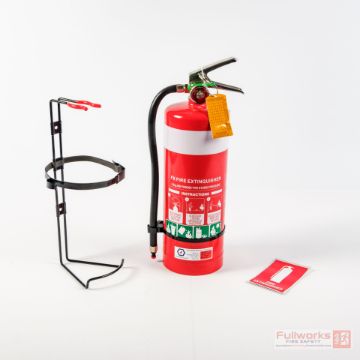Dry chemical powder (DCP) fire extinguishers are one of the most common fire extinguishers used in Australia. The reason for this is their ability to tackle many different types of fire, their effectiveness at fighting fires and also the low cost of DCP extinguishers available.
Identifying dry chemical powder fire extinguishers
DCP fire extinguishers are easily distinguishable by the white band that is around the fire extinguisher cylinder near the top and if installed in a building they should also be identified by what is known as a description sign, which describes what fires the fire extinguisher can and cannot be used for.
Be aware that there are 2 types of dry chemical powder fire extinguishers, there are both ABE and BE type extinguishers.
The most common type is know as an ABE dry chemical powder fire extinguisher. This is derived from the classes of fire that the extinguisher is effective against - Class A, B and E.
The second type of dry chemical powder fire extinguisher is known as a BE dry chemical powder fire extinguisher. This is again derived from the classes of fire that the extinguisher is effective against - Class B and E. BE type dry chemical powder fire extinguishers are much less common that ABE type.
Both types of dry chemical powder fire extinguishers have the white band, however the desciption sign should be different.
What fires can dry chemical powder fire extinguishers be used on?
As has already been mentioned, dry chemical powder fire extinguishers and extremely effective and versatile.
ABE Type :-
- Class A Fires - paper, cardboard, wood, fabrics, people etc.
- Class B Fires - flammable liquid fires, petrol, deisel, oil etc
- Class E Fires - electrical fires, computers, photocopiers, switchboards etc
BE Type:-
- Class B Fires - flammable liquid fires, petrol, deisel, oil etc
- Class E Fires - electrical fires, computers, photocopiers, switchboards etc
- Class F Fires - although not included in the rating the BE type is capable of extinguishing cooking oil fires
Both types of dry chemical powder fire extinguishers can be used on flammable gas fires, however evaluate the situation carefully before doing this, as burning gas eliminates the gas, whereas if the fire is extinguished, the gas can continue to leak, build up and become a potential bomb if ignition is triggered.
How do dry chemcial powder fire extinguishers work?
All fire extinguishers work by removing one or more elements of the fire triangle - heat, fuel and oxygen
The dry chemical powder use in most ABE fire extinguishers is called monoammonium phosphate. This powder has the ability to melt and flow once heated which allows it to coat the fuel and extinguish the fire especially class A and E fires. With class B fires the powder smothers the surface of the fire and stops the vapour (fuel) escaping and therefore extinguishing the fire straight away. Flammable liquid fires do not generally store much heat in the fuel source, therefore the powder will not normally melt.
BE type dry chemical powder extinguishers differ in that they do not melt onto the fuel surface and are therefore ineffective against class A fires giving them a BE rating.
What are the advantages of dry chemical powder extinguishers?
Dry chemical powder fire extinguishers have a few advantages when compared to other fire extinguishers:-
- Versatile - can be used on many different types of fire
- Powerful - extinguish fires quickly
- Compact - when comparing effectiveness / size against other types of fire extinguisher
- Economical - low prices gives them a great price / performance ratio
- Coverage - can provide fire protection for large areas
- Variety - come in may differing sizes and ratings
- Safe - due to their versatility they are safe for use on electrical fires
What are the disadvantages of dry chemical powder extinguishers?
Dry chemical powder fire extinguishers also have a few disadvantages when compared to other fire extinguishers:-
- Cleanup - due to the powder cleanup can be extensive after use
- Dust - The dust can affect sensitive equipment such as computers
- Visibility - When used in enclosed spaces visibility can be reduced to almost zero. Always know where the exit is before use!
- Respiratory - The powder can make breathing almost impossible in enclosed spaces.
- Single shot - Although all fire extinguishers should be refilled / replaced after use, dry chemical powder fire extinguishers lose pressure quickly even if only actived for a fraction of a second. This is due to the powder getting stuck in the valve and allowing the pressure to leak.
- Compacted powder - If not serviced or not correctly serviced the dry chemical powder can settle and compact at the bottom of the fire extinguisher. This result in the powder not discharging either fully or correctly when used.
How to use dry chemical powder fire extinguishers?
Dry powder fire extinguishers are similar to most other fire extinguishers in operation. Just remember the PASS principle!
Pull the Pin - Aim the nozzle at the base of the fire - Squeeze the handle - Sweep from side to side







